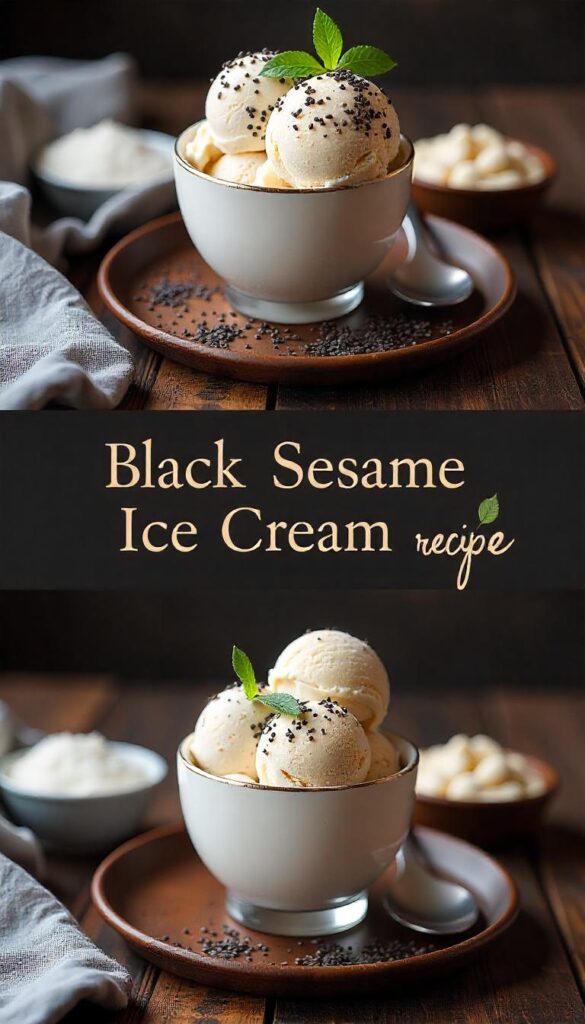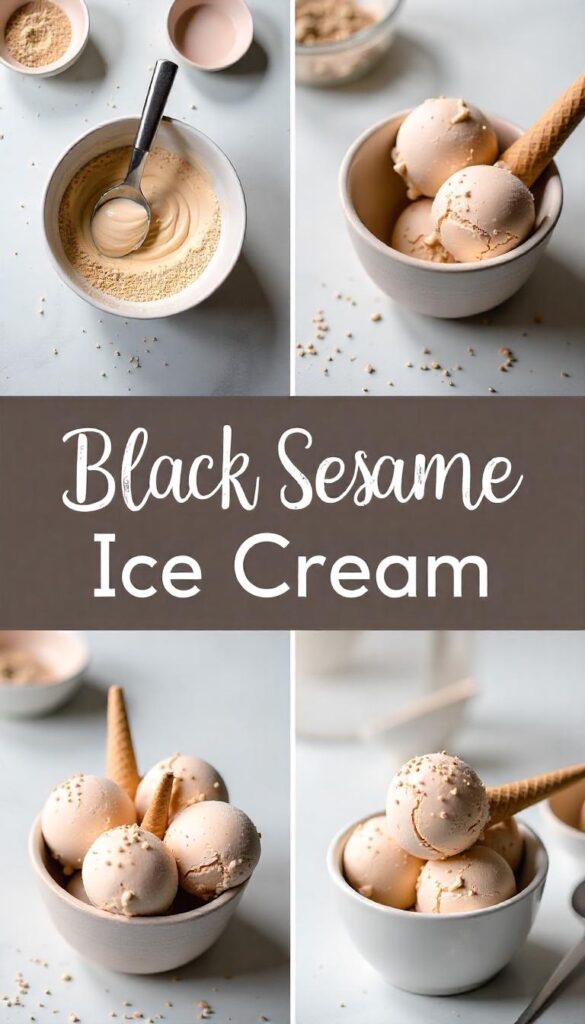Black sesame ice cream is a luxurious, deeply flavored treat that boasts a rich nutty aroma and an exotic edge. Originally popularized in East Asian countries like Japan, China, and Korea, this dessert has gained global admiration for its unique grayish hue and bold, roasted sesame flavor. The Black Sesame Ice Cream Recipe is a delightful departure from conventional vanilla or chocolate varieties—perfect for adventurous eaters and fans of Asian-inspired cuisine.
This ice cream not only offers visual appeal with its dramatic charcoal-gray color but also delivers a smooth, creamy texture enhanced by the natural oils in toasted black sesame seeds. It’s the ideal fusion of East and West, bringing traditional Japanese ingredients into the classic Western-style ice cream-making process.
Whether you’re preparing it for a dinner party, a summer afternoon treat, or simply indulging in your culinary curiosity, this recipe is a must-try. Read on to learn how to make this rich, nutty, and creamy dessert from scratch.
Nutrition Facts (Per Serving – Based on 6 servings)
-
Calories: 280 kcal
-
Protein: 5g
-
Carbohydrates: 20g
-
Sugar: 16g
-
Fat: 22g
-
Saturated Fat: 10g
-
Fiber: 1g
-
Cholesterol: 120mg
-
Sodium: 40mg
-
Calcium: 90mg
-
Iron: 1.5mg
Prep Time, Active Time, Resting Time & More
-
Prep Time: 20 minutes
-
Active Time: 15 minutes
-
Resting Time / Chilling + Freezing: 6–8 hours (or overnight)
-
Total Time: ~8 hours 30 minutes
-
Cuisine: Japanese / East Asian
-
Course: Dessert
-
Servings: 6
-
Calories per Serving: 280 kcal
Equipment Needed
-
Ice cream maker (optional, but recommended)
-
Saucepan
-
Blender or spice grinder
-
Whisk
-
Mixing bowls
-
Fine-mesh sieve
-
Airtight container (for storage)
-
Spatula
-
Measuring cups and spoons
Ingredients
For the Black Sesame Paste:
-
1/2 cup black sesame seeds (toasted)
-
2 tablespoons honey or maple syrup (for vegan version)
-
1 tablespoon sesame oil or neutral oil
For the Ice Cream Base:
-
2 cups whole milk
-
1 cup heavy cream
-
4 large egg yolks
-
1/2 cup granulated sugar
-
1 teaspoon vanilla extract
-
Pinch of salt
Instructions
Step 1: Toast the Black Sesame Seeds
Place the black sesame seeds in a dry skillet over medium heat. Stir frequently for 3–5 minutes until the seeds become fragrant and begin to pop slightly. Be careful not to burn them. Toasting enhances the depth of flavor.
Step 2: Make the Black Sesame Paste
Let the toasted seeds cool slightly. Transfer them to a blender or spice grinder and grind into a fine powder. Add honey and sesame oil, then blend until you get a smooth, thick paste. Set aside. This can be made in advance and stored in the fridge.
Step 3: Heat the Milk and Cream
In a medium saucepan, combine whole milk and heavy cream. Heat over medium heat until it just starts to simmer. Do not boil. Remove from heat.
Step 4: Prepare the Egg Yolk Mixture
In a separate bowl, whisk the egg yolks and sugar together until pale and creamy. This will help the sugar dissolve and create a silky custard base.
Step 5: Temper the Eggs
Slowly pour a small amount (about ½ cup) of the hot milk mixture into the egg yolk mixture while whisking constantly to prevent curdling. Gradually add more milk, then return everything to the saucepan.
Step 6: Cook the Custard
Cook the mixture over low-medium heat, stirring constantly with a spatula or wooden spoon. Stir until the mixture thickens and coats the back of the spoon (about 170–175°F / 77–80°C). This should take about 5–7 minutes. Be patient—do not let it boil.
Step 7: Add the Black Sesame Paste
Once the custard has thickened, remove from heat and whisk in the black sesame paste and a pinch of salt until fully incorporated. If needed, use a hand blender for a smooth texture.
Step 8: Strain and Chill
Pour the mixture through a fine-mesh sieve into a clean bowl to remove any lumps or seed fragments. Let it cool to room temperature, then cover and refrigerate for at least 4 hours or overnight.
Step 9: Churn the Ice Cream
Once fully chilled, pour the custard into your ice cream maker and churn according to the manufacturer’s instructions. It usually takes about 20–25 minutes.
Step 10: Freeze Until Firm
Transfer the churned ice cream into an airtight container and freeze for at least 2 hours or until firm. You can also enjoy it as soft serve immediately after churning.
Tips & Variations
-
No Ice Cream Maker? After chilling the custard, pour it into a container and freeze, stirring every 30 minutes for 3 hours to break up ice crystals.
-
Vegan Option: Replace milk and cream with full-fat coconut milk, and use a vegan sweetener like maple syrup. Omit egg yolks or use a vegan custard powder.
-
Sweetness Adjustments: You can increase sugar slightly for a sweeter flavor or decrease for a more robust sesame taste.
-
Serving Suggestions: Pair with mochi, drizzle with condensed milk, or sprinkle toasted sesame seeds on top for extra crunch.
Why You’ll Love This Black Sesame Ice Cream Recipe
This Black Sesame Ice Cream Recipe stands out for its bold flavor and visual appeal. The nutty, slightly bitter sesame flavor balances beautifully with the creaminess of the custard base, creating a dessert that is rich without being overpowering. It’s a conversation starter and a crowd-pleaser—whether served in a cone, as a scoop beside a dessert, or in a minimalist Asian-style parfait.
Not only is it delicious and eye-catching, but it’s also an easy way to introduce new flavors to your dessert rotation. Once you master this recipe, you’ll likely want to explore other sesame-inspired treats.
Final Thoughts
Black sesame ice cream may not be the first flavor that comes to mind, but once you taste it, it’s bound to become one of your favorites. Whether you’re making it for a cultural celebration, experimenting with Asian ingredients, or simply craving a unique dessert, this homemade version is a step above any store-bought alternative.

I am Ashley Doyle, Senior Specialist in Food & Policy at The Humane Society of the United States and editor at airfryermama.com. I am passionate about transforming our global food system by promoting delicious, climate-friendly, plant-based foods. After transitioning from law to food and public policy, I now work with major food service companies to develop plant-based initiatives and animal welfare policies. My goal is to drive institutional change to combat climate change and improve our food system.


